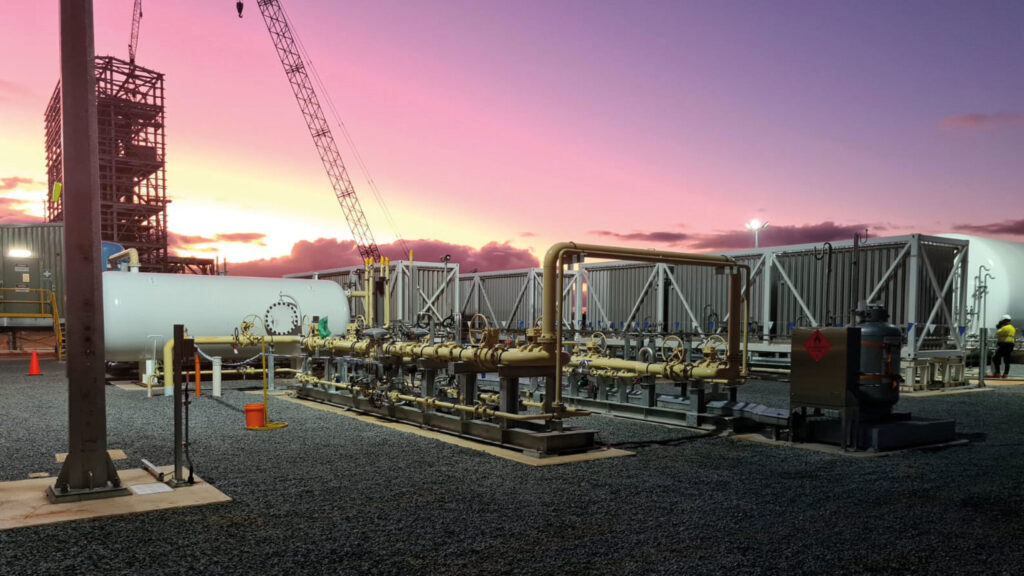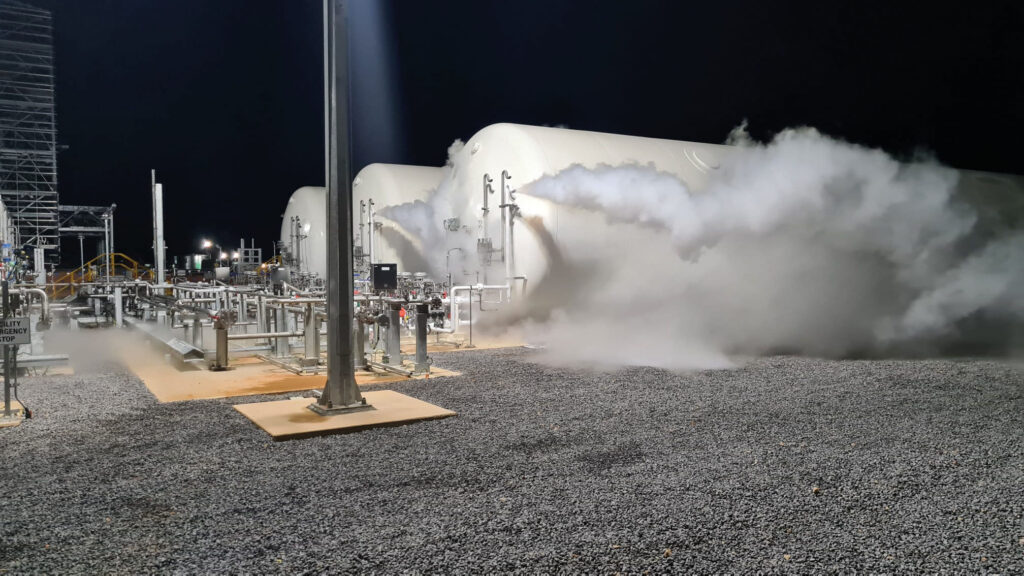A mine extracting mineral sands in the Australian Outback requires a reliable energy supply. Numerous HEROSE valves are in operation at the local LNG facility.
In the Kimberley region in northwest Australia lies the Thunderbird Mineral Sands Project, where valuable mineral sands are extracted through open-cast mining. The nearest town is 70 kilometres away, with no power or gas lines leading to the mining site. The mining operation depends on a reliable energy supply. The Perth-based company AMG Energy Services designed and supplied the entire LNG value chain. The LNG facility is operated by Pacific Energy, Australia’s leading remote, off-grid energy provider.

The complete LNG energy system, including the pneumatically actuated HEROSE globe valves, is remotely controlled and monitored by Pacific Energy from their Perth office.
Great distances, high temperatures, and lots of dust
The Australian continent covers 7.7 million km2, almost twice the size of all European Union countries combined. While the EU is home to 448 million people, Australia has a population of 27 million. The Kimberley region is the hottest part of Australia, with winter temperatures ranging from 30 to 35 degrees Celsius and summer tempera- tures reaching 40 to 45 degrees Celsius, accompanied by high humidity up to 99 percent in summer. The Thunderbird mining project is located on the Dampier Peninsula, halfway between Derby and Broome. The location and climate pose significant challenges for both workers and equipment.
Mineral sands in Australia
Australia is one of the world’s largest exporters of raw materials, and its mining industry is a key economic sector. While mineral sands receive less attention than other resources, they are of great importance, as the country is among the world’s leading producers of these essential raw materials. Mineral sands are heavy mineral deposits often found in former coastal regions or ancient riverbeds. They contain valuable minerals such as the titanium compounds ilmenite, rutile, and leucoxene, as well as the silicate mineral zircon. The Thunderbird Mine is one of the largest and highest-quality zircon deposits in the world, approximately 50% larger than the largest currently operating mining site.
LNG ensures sufficient energy while mineral sands extraction
Around 350 people live in the mining camp of Kimberley Mineral Sands. Mineral sand extraction operates 24/7. The energy supply must be secured for both mining operations and Thunderbird Village, which includes a restaurant, gym, recreation room, shop, and administrative offices. Many mines still use diesel generators to produce electricity. LNG is a lower-carbon alternative for power generation at remote mining locations. Using natural gas results in 25% fewer CO2 emissions and eliminates sulphur and nitrogen oxides. Additionally, diesel must be imported from overseas, whereas gas is produced locally in Australia. Perth-based AMG Energy Services designed and planned the LNG energy system and built it in collaboration with its partner Furui in China and Australia.
The environmental conditions are the greatest challenge. We must ensure the reliability of the facility 365 days a year – that is crucial.
Kevin Gao, Managing Director AMG Energy Services
A comprehensive LNG system with three large storage tanks
AMG Energy Services specializes in cryogenic pressure vessels and LNG energy systems. For the Thunderbird Mine, the company implemented the entire LNG value chain: from LNG trucks carrying up to three tank trailers with a capacity of 63 tons per transport to the three large storage tanks and facility control systems. Each of the three storage tanks is 30 meters long, 5 meters high, and 5.5 meters wide, with a capacity of approximately 370,000 cubic meters and a weight of 122 tons. When filled to 80% capacity, these tanks can supply Thunderbird with energy for ten days. Daily consumption ranges from 25 to 40 tons of LNG, with two to three trucks delivering fresh supplies each day. The gas originates from the Pluto offshore fields west of Australia and is transported via a 180 km pipeline to the liquefaction plant in Karratha. The Pluto LNG truck-loading facility can load up to 200,000 tons of LNG per year, replacing around 300 million litres of diesel. The distance from the truck terminal to the mine is approximately 930 km.
Reliable energy is essential
The gas power plant at the Thunderbird Mine site has a capacity of 16 MW, complemented by a 2 MW battery storage system. This energy supply is crucial for both mining operations and the 350 residents of Thunderbird Village. Kevin Gao from AMG Energy Services emphasises that reliability is the top priority in such a challenging environment: „The entire facility must be highly reliable, meaning that every single component must be dependable.“ Therefore, AMG focused on quality and reliability when selecting valves for the LNG facility. They chose HEROSE products, also due to their excellent customer service, as highlighted by Kevin Gao. Various HEROSE valves are used at critical points in the facility, including safety valves and pneumatically operated globe valves. The facility is entirely remotely controlled by Pacific Energy in Perth. HEROSE globe valves operate in the LNG liquid inlet pipe, vapour pipe, and liquid outlet pipe. HEROSE safety valves protect the storage and transport tanks from excessive pressure.
Valuable heavy minerals
As one of the world’s largest and highest-quality mineral sand deposits, the Thunderbird Project is of great significance. The mineralisation, located in the heavily weathered Broome Sandstone, lies in a thick, wide, and flat body relatively close to the surface. Initially, topsoil and overburden are removed using excavators and trucks. The valuable mineral sands are then extracted in a “movable cavity”. Waste material is returned to the cavity, enabling gradual rehabilitation of the mined area. Minimising environmental impact is a key goal of the project, alongside ensuring safety in all aspects and protecting native heritage.
Mineral sands are in high demand internationally
The mined mineral sand is screened, slurried and pumped to a connected wet concentration plant. In the processing plant, the sand is washed to remove unwanted substances and divided into individual fractions using spiral concentrators. The finished mineral products are then available in the form of powders or grains. The mine‘s processing plant can process up to 10.4 million tonnes of sand per year. Operations at the Thunderbird mine commenced in October 2023 and the first shipment of 300 tonnes of non-magnetic zircon concentrate was shipped to China via the port of Port Hedland in January 2024. The mineral sands will be delivered either in bulk or in large bags. The mine life is forecast to be 36 years, with significant production of zircon and ilmenite.
Areas of application for mineral sands
| Material | Properties | Utilisation |
| Zirconium | High temperature and radiation resistance | Ceramics, refractory materials, nuclear industry |
| Magnetic ilmenite | Higher iron content | Steel alloys, welding electrodes, electronics |
| Non-magnetic ilmenite | Higher degree of purity | Production of high-purity titanium dioxide, cosmetics, glass and ceramics production, catalysts |
AMG Energy Services
The AMG Energy Services team specializes in developing small scale LNG Projects, designing, producing, and selling cryogenic pressure vessels for storage and mobile LNG tanks used on roads and ships, as well as LNG vaporisers. New projects also include handling ammonia, liquid argon, oxygen, and nitrogen.
Kimberly Mineral Sands
The Thunderbird Mineral Sands Project is a 50/50 joint venture between Sheffield and YGH Australia Investment Pty Ltd (Yansteel), established in 2021. Thunderbird‘s production of mineral sands with high zircon and titanium content is in global demand.




 Read the current digital customer magazine now!
Read the current digital customer magazine now!
